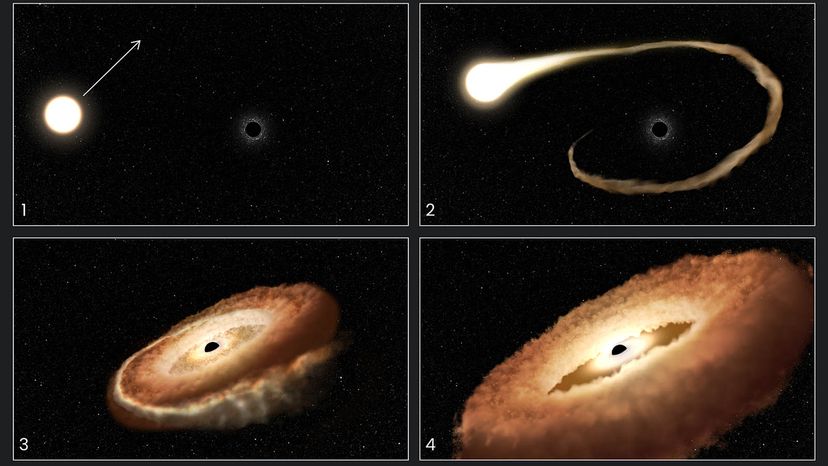
Astronomers Studied More Than 5,000 'Winking' Black Holes to Figure Out Why They Twinkle
Share
Even astronomers find black holes bizarre. The mass of these objects bends the surrounding space so tightly that even light cannot escape.
Despite their famed blackness, some black holes can be seen. Before the gas and stars are sucked into the hole, they are sucked into glowing discs that can shine brighter than entire galaxies.
Even stranger, these black holes wink. The glowing discs' brightness can fluctuate daily, and people are still determining why.
To understand why these winkings occur, we observed over 5,000 of the fastest-growing black holes in the sky for five years using NASA's asteroid defence program.
Using friction and intense gravitational and magnetic fields, we report our answer in Nature Astronomy.
Hungry Holes
In galaxies, supermassive black holes with masses equivalent to millions or billions of Suns are found at their centers.
One of these giants is at the center of our galaxy, the Milky Way, with a mass of about four million Suns. Approximately 200 billion stars in our galaxy (including our Sun) orbit around the black hole at its center.
All galaxies, however, are not so peaceful. Many stars may be pulled too close to their galaxy's black hole when two galaxies pull on each other via gravity. As a result, the stars are torn apart and devoured.
Our best guess is that this must have happened in galaxies with black holes weighing a billion Suns, as we can't imagine how they could have grown so large. The Milky Way may have also experienced this in the past.
It is also possible for black holes to feed slowly and gently on gas emitted by geriatric stars known as red giants.
Make Yum Yum
A new study looked closely at the feeding process among the 5,000 fastest-growing black holes in the Universe. In earlier studies, we discovered the black holes with the most voracious appetite. Last year, we found a black hole that eats an Earth's-worth of stuff every second. In 2018, we found one that eats a whole Sun every 48 hours.
But we have lots of questions about their actual feeding behaviour. We know the material on its way into the hole spirals into a glowing "accretion disc" that can be bright enough to outshine entire galaxies. These visibly feeding black holes are called quasars.
Most of these black holes are a long, long way away–much too far for us to see any detail of the disc. We have some images of accretion discs around nearby black holes, but they merely breathe in some cosmic gas rather than feasting on stars.
The Five-Year-Flickering Holes
NASA's ATLAS telescope in Hawaii was used in this latest study. Every night (weather permitting), it scans the entire sky for asteroids approaching Earth from the outer darkness.
Besides providing a nightly record of hungry black holes deep in the background, these whole-sky scans also provide a snapshot of how they glow at night. In a five-year movie, the team shows the day-to-day changes in brightness of each black hole caused by the bubbling and boiling accretion disc.
We can learn something about accretion discs from the winking of these black holes.
In 1998, astrophysicists Steven Balbus and John Hawley proposed a theory of "magneto-rotational instabilities" that describes how magnetic fields can cause turbulence in the discs. If that is the right idea, then the discs should sizzle in regular patterns.
They would wink in random patterns that unfold as the discs orbit. Larger discs orbit more slowly with a slow wink, while tighter and faster orbits in smaller discs wink more rapidly.
In the real world, would the discs prove as simple as this? A separate question might be whether "simple" is the right word to describe turbulence in an ultra-dense, out-of-control environment surrounded by intense gravitational and magnetic fields.
Using statistical methods, the study measured how much the light emitted from the 5,000 discs flickered over time. The pattern of flickering in each one looked somewhat different.
But when sorted by size, brightness, and colour, they saw intriguing patterns and could determine the orbital speed of each disc – and once you set your clock to run at the disc's speed, all the flickering patterns looked the same.
The theory of "magneto-rotational instabilities" predicts this universal behaviour.
That was very comforting! Thus, these mind-boggling maelstroms are actually quite simple.
Additionally, it opens up a whole new world of possibilities. We believe the remaining subtle differences between accretion discs are because we are looking at them from different angles.
The next step is to examine these subtle differences more closely and see whether they hold clues to discern a black hole's orientation. Eventually, our future measurements of black holes could be even more accurate.
You’ve come this far…
Why not venture a little further into A.S.S. - our exclusive Australian Space Society.
And keep thrusting Australia into the deep unknown…
#Space_Aus





